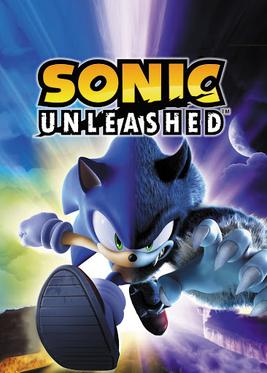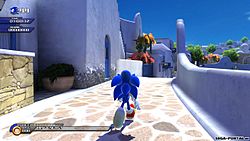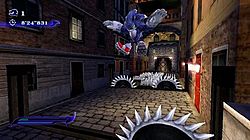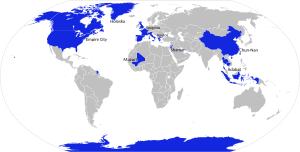Sonic Unleashed facts for kids
Quick facts for kids Sonic Unleashed |
|
|---|---|
 |
|
| Developer(s) | Sonic Team |
| Publisher(s) | |
| Director(s) | Yoshihisa Hashimoto |
| Producer(s) | Akinori Nishiyama |
| Designer(s) |
|
| Artist(s) |
|
| Writer(s) | Kiyoko Yoshimura |
| Composer(s) |
|
| Series | Sonic the Hedgehog |
| Platform(s) | |
| Release date(s) |
November 18, 2008
PS2, Wii, Xbox 360
PlayStation 3
|
| Genre(s) | Platformer, action-adventure, beat 'em up |
| Mode(s) | Single-player |
Sonic Unleashed is a video game from 2008 in the popular Sonic the Hedgehog series. In this game, Sonic tries to fix the world after his enemy, Doctor Eggman, breaks it into pieces. Eggman uses a powerful laser to release an old evil creature called Dark Gaia.
During this adventure, Sonic also turns into a "Werehog" at night. This is a bit like a werewolf, making him super strong but slower. The game has two main ways to play: fast-paced levels during the day and slower, action-packed levels at night.
The game was made by Sonic Team and Sega. It was a big deal when it came out, selling over 2 million copies! People liked the fast daytime levels and the cool graphics. However, some players weren't so sure about the Werehog parts.
Contents
How to Play Sonic Unleashed
Sonic Unleashed is a platform game. You control Sonic the Hedgehog in two different forms.
During the day, Sonic is super fast, just like in other Sonic games. These levels are all about speed! At night, Sonic changes into the Werehog. These levels are slower and focus on fighting enemies and solving simple puzzles.
Each level in the game is set on a different continent. These places are inspired by real-world locations. In some versions of the game (Xbox 360 and PlayStation 3), you can choose if it's day or night. In other versions (Wii and PlayStation 2), the time changes automatically.
Daytime Levels: Go Fast with Sonic!
Daytime levels are all about Sonic's amazing speed. You race through stages that mix 2D and 3D gameplay.
- 2D parts look like older Sonic games. You move Sonic from side to side.
- 3D parts have the camera behind Sonic. You can move him in all directions.
Sonic has his classic moves, like the Homing Attack. He also gets new ones:
- Quick Step: Lets Sonic quickly dodge left or right.
- Drift: Helps Sonic make tight turns without slowing down.
- Sonic Boost: Makes Sonic go super fast! He can smash through things and enemies.
In the Xbox 360 and PlayStation 3 versions, you have a "Ring Energy" bar for the Boost. Collecting rings fills it up. In the Wii and PlayStation 2 versions, you get Boost bars by collecting rings or by defeating many enemies quickly.
Night-time Levels: Unleash the Werehog!
Night-time levels are slower and focus on action and fighting. Sonic turns into his "Werehog" form. As the Werehog, Sonic has super strength and arms that can stretch!
You can use the Werehog to:
- Grab distant objects.
- Move things around.
- Do cool combo attacks to beat enemies.
Collecting rings helps the Werehog get his health back. There's also a special move called "Unleashed Mode." This makes the Werehog's attacks even stronger for a short time.
The Wii version uses the Wii Remote and Nunchuk. You can control the Werehog's arms by moving your hands. This makes the game feel even more interactive!
Exploring the World and Collecting Medals
The game also has "hub worlds." These are places where you can walk around and learn more about the story.
- In the PlayStation 3 and Xbox 360 versions, these hub worlds are big 3D areas. You can talk to people and do side quests. These quests can help you get experience or unlock cool extras like artwork and music.
- In the Wii and PlayStation 2 versions, the hub worlds are simpler. You just click on areas on a map to talk to people.
In both day and night levels, you can find Sun and Moon Medals.
- In the Xbox 360 and PlayStation 3 versions, these medals help Sonic get stronger. You need a certain number of medals to unlock new levels. You can also find them by exploring towns and doing side quests.
- In the Wii and PlayStation 2 versions, you earn medals by finishing levels.
These medals are important! You use them to open special doors called Gaia gates. These gates can lead to bonus content.
The Story of Sonic Unleashed
The story begins with Sonic chasing Doctor Eggman through space. Sonic turns into Super Sonic and traps Eggman. But Eggman has a trick! He uses a powerful laser to steal Sonic's Super Sonic power and the Sonic the Hedgehog (series)#Chaos Emeralds. The Emeralds turn gray and useless.
Eggman then uses the Emeralds' energy to fire a huge laser. This laser wakes up a powerful monster called Dark Gaia from inside the planet! The planet breaks into seven pieces. As a side effect, Sonic turns into a "Werehog" at night. He lands safely on the broken planet thanks to a strange green shield.
Sonic meets a small, friendly creature who can't remember anything. Sonic thinks he caused the creature's memory loss, so he decides to help him. Sonic names him "Chip."
Sonic and Chip start their adventure. With help from friends like Amy and Tails, they travel the world. They need to find special Gaia Temples. These temples will restore the Chaos Emeralds' power and put the world back together. They also hope to turn Sonic back to normal.
After putting six of the seven continents back together, Chip remembers who he is! He is Light Gaia, the opposite of Dark Gaia. For a long time, Dark Gaia would break the planet, and Light Gaia would fix it. Both of them woke up too early this time. That's why Chip lost his memory, and Dark Gaia was broken into pieces.
They place the last Chaos Emerald in a temple in Eggman's new base, "Eggmanland." But Eggman attacks them! Sonic defeats Eggman, who is using a robot powered by Dark Gaia. During the fight, Sonic, Chip, and Eggman fall into the Earth's core. They meet Dark Gaia!
Eggman tells Dark Gaia to destroy Sonic, but Dark Gaia turns on Eggman instead. It then takes away the power that turned Sonic into a Werehog, making Sonic normal again. Dark Gaia attacks Sonic and Chip. Chip protects Sonic and calls all the Gaia temples together. They form a giant robot called the Light Gaia Colossus to fight Dark Gaia.
The Colossus seems to destroy Dark Gaia, but the monster isn't finished! It covers the whole world in darkness and becomes Perfect Dark Gaia. Chip gives the restored Chaos Emeralds to Sonic. Sonic turns into Super Sonic and finally destroys Perfect Dark Gaia.
Dark Gaia goes back into the planet. The fight leaves Super Sonic weak. Chip saves Sonic by throwing him to the surface. Chip then returns to the planet's core. He leaves his necklace behind. Sonic wears the necklace as a bracelet to remember their adventure. He then speeds off with Tails in the Tornado plane.
How Sonic Unleashed Was Made
Sonic Team started making this game in 2006. They had already begun working on the game's special technology, called the Hedgehog Engine, in 2005.
The name Sonic Unleashed was first used by Sega in March 2008. Soon after, pictures and a video of the game were leaked online. Sega officially confirmed the game in April 2008.
The game was first planned to be the third game in the Sonic Adventure series. It was even called Sonic World Adventure at one point. But the team added so many new ideas that it became its own game, Sonic Unleashed. In Japan, it kept the name Sonic World Adventure.
The creators decided to focus on just Sonic as the main character. They wanted to make sure he was really well-made. They also wanted to help new players understand the Sonic games. This is why they came up with the idea of the Werehog.
The director, Yoshihisa Hashimoto, knew that some people might not like the Werehog idea. But he hoped that long-time Sonic fans would understand their choices. Japanese artists Gurihiru designed the human characters in the game.
The game's visuals were made to look very realistic. They used a special lighting system to make light bounce off objects. This made the game world look amazing!
Because the game was made for different game consoles (some more powerful than others), two different versions were developed:
- One version for Xbox 360 and PlayStation 3 used the new Hedgehog Engine.
- Another version for Wii and PlayStation 2 used a changed version of an older Sega engine.
Hashimoto added new features like the "Quick Step" to help players dodge things. He wanted to mix the best parts of 2D and 3D Sonic games. He also wanted to fix problems that players had with previous 3D Sonic games.
The Wii version had special controls using the Wii Remote. It also let players use a GameCube controller or Classic Controller. The company Dimps helped design some of the daytime levels for the Wii and PlayStation 2 versions. These versions also had fewer daytime levels than the Xbox 360 and PlayStation 3 versions.
The game was released in North America in November 2008 for PlayStation 2, Wii, and Xbox 360. The PlayStation 3 version came out in December 2008. In Japan, the Wii version came out in December 2008, and the Xbox 360 and PlayStation 3 versions came out in February 2009.
Later, new levels and missions were added to the game as downloadable content. These included levels in places like Chun-nan, Spagonia, and Apotos.
A company called Gameloft also made a version of Sonic Unleashed for mobile phones. This mobile version was a side-scrolling game, like the very first Sonic games.
Music in Sonic Unleashed
The music for the game was released as a three-disc album in Japan. The main song, "Endless Possibility," was sung by Jaret Reddick from the band Bowling for Soup. The ending song, "Dear My Friend," was a slower song sung by Brent Cash.
Sonic Unleashed's Impact
Sonic Unleashed had a lasting effect on the Sonic series.
- Archie Comics made a comic book based on the game's story.
- A short animated movie called Sonic: Night of the Werehog was released in 2008. It showed Sonic as the Werehog.
The special game engine used for Sonic Unleashed, the Hedgehog Engine, was improved and used in later Sonic games. These include Sonic Generations (2011) and Sonic Forces (2017). The fast daytime gameplay style from Unleashed became a very important part of how Sonic games were made for many years after.
To celebrate Sonic's 20th anniversary, Sega released Sonic Generations. This game remade famous levels and boss fights from different Sonic games. It included a remake of the "Rooftop Run" stage and the Egg Dragoon boss fight from Sonic Unleashed. The 2017 game Sonic Forces also had a new version of the Egg Dragoon boss.
See also
In Spanish: Sonic Unleashed para niños




